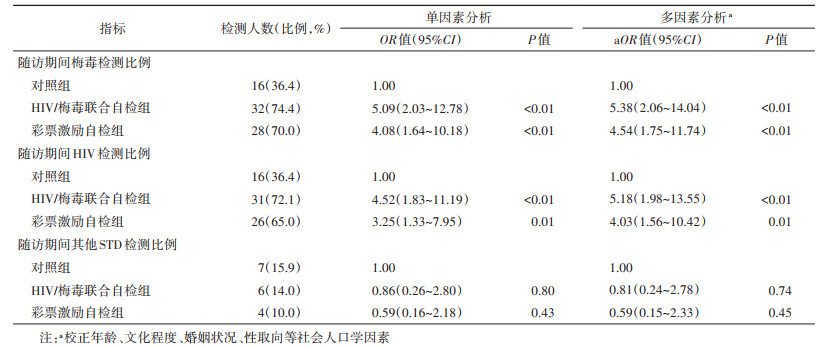文章信息
- 赵培祯, 程伟彬, 唐卫明, 郑和平, 杨斌, 王成.
- Zhao Peizhen, Cheng Weibin, Tang Weiming, Zheng Heping, Yang Bin, Wang Cheng
- 通过HIV/梅毒联合自我检测促进男男性行为人群进行梅毒检测的效果研究
- Evaluating the effectiveness of HIV/syphilis joint self-testing in promoting syphilis testing among men who have sex with men
- 中华流行病学杂志, 2021, 42(2): 273-277
- Chinese Journal of Epidemiology, 2021, 42(2): 273-277
- http://dx.doi.org/10.3760/cma.j.cn112338-20200624-00880
-
文章历史
收稿日期: 2020-06-24
2. 美国北卡罗来纳大学教堂山分校中国项目办, 广州 510095
2. University of North Carolina at Chapel Hill, Project-China, Guangzhou 510095, China
梅毒是我国及世界范围内重要的STD之一,对我国“健康中国2030”目标的实现构成了重大挑战。MSM是受梅毒影响的重点人群之一。WHO估计全球有至少42个国家MSM梅毒感染率超过5%,至少20个国家感染率超过10%,至少8个国家感染率超过20%[1]。有Meta分析显示我国MSM梅毒新发感染率高达9.6/100人年[2]。未经治疗的梅毒不仅会导致严重的并发症,而且会增加感染和传播HIV的风险,对我国艾滋病综合防治带来挑战。促进梅毒检测是梅毒防控的重要手段之一,我国MSM梅毒检测比例仍处于较低水平,且有30%的MSM从未检测过梅毒[3]。2018年全国开展横断面调查发现,MSM仅有24.9%曾进行过梅毒自我检测(自检)[4]。HIV/梅毒自检能有效提高MSM梅毒检测水平,本研究目的是评估HIV/梅毒联合自检在促进MSM梅毒检测方面的作用,为推动MSM梅毒自检工作提供参考依据。
对象与方法1. 研究对象:2019年7月通过淡蓝网(https://www.danlan.org)招募研究对象,纳入标准:①年龄≥18岁;②男性;③最近1年发生同性无保护肛交;④最近6个月未检测过梅毒且有检测需求;⑤当前未感染梅毒/梅毒感染状态不明;⑥研究期间继续在国内居住并愿意提供邮寄地址。本研究经南方医科大学皮肤病医院伦理委员会批准(GDDHLS-20181206),所有研究对象均签署知情同意书。
2. 研究设计和样本量:采用PASS 15.0软件估算样本量,对照组的梅毒检测比例估计为30.0%,HIV/梅毒联合自检组检测比例估计为65.0%,检验水准α=0.5,检验功效(1-β)=0.9,估计脱失率为20%,每个组估计48例。本研究纳入150人,每组50人。
3. 随机分组和干预措施:按照1∶1∶1比例,研究对象随机分为3组(HIV/梅毒联合自检组、彩票激励自检组、对照组),分别采用不同的梅毒检测策略:①HIV/梅毒联合自检组:提醒并转介研究对象到当地医疗卫生机构免费检测梅毒,如果研究对象愿意梅毒自检并向课题组提出申请需求,课题组免费邮寄其1份HIV/梅毒联合自检试剂套装;②彩票激励自检组:内容同①,同时,如果研究对象完成梅毒检测并上传结果,可获取1次抽奖机会(10%机会赢取100元现金奖励);③对照组:提醒研究对象检测梅毒,并转介到当地医疗卫生机构免费检测梅毒。
4. HIV/梅毒自检试剂:自检试剂采用的是SD Bioline HIV/梅毒双重检测(美国雅培公司),采用胶体金法可同时定性检测梅毒和HIV[5]。
5. 资料收集:在基线和1个月后分别收集数据。基线问卷收集社会人口学特征、性行为、吸毒行为、HIV和梅毒检测状况、梅毒自检的态度等信息。在随访问卷收集最近1个月在诊所和社区场所梅毒检测(包括梅毒自我检测、医疗机构检测)、HIV检测和其他STD检测的信息。
问卷收集采用问卷星并申请梅毒自检试剂[6]。检测结果通过问卷星或微信好友上传获得,检测结果包括梅毒自检和医疗机构检测结果。主要结局指标为随访期间梅毒检测的比例,该指标通过研究对象上传检测结果图片收集,判断为完成梅毒检测。次要结局指标为HIV和其他STD检测(衣原体、淋病、尖锐湿疣和生殖器疱疹)的比例,该指标通过随访问卷收集。
6. 统计学分析:采用SPSS 22.0软件进行数据分析,分类资料采用频数/频率描述,采用χ2检验比较组间指标的差异,采用logistic回归分析各组的HIV、梅毒、其他STD检测比例的差异,多因素logistic回归分析校正年龄、文化程度、婚姻状况、性取向等社会人口学因素,参考项目前期经验以及有向无环图(directed acyclic graph,DAG)进行判断。双侧检验,检验水准α=0.05。
结果1. 一般情况:招募MSM 211人,纳入研究对象145人,按照1∶1∶1比例随机分配到3个组(HIV/梅毒联合自检组49人、彩票激励自检组48人、对照组48人)。1个月后的随访率,HIV/梅毒联合自检组、彩票激励自检组和对照组分别为87.8%(43人)、83.3%(40人)、91.7%(44人)。见图 1。

|
| 图 1 过HIV/梅毒联合自我检测促进男男性行为人群进行梅毒检测的效果研究流程 |
2. 基本特征:18~25岁占65.5%(95/145),未婚占91.7%(133/145),从未检测梅毒的占79.3%(115/145)。HIV/梅毒联合自检组、彩票激励自检组和对照组的基线特征比较,3个组的社会人口学、性行为特征差异无统计学意义。见表 1。
3. 梅毒自检服务利用情况:HIV/梅毒联合自检组有38人成功申请自检试剂;彩票激励自检组有35人成功申领到了自检试剂。随访期间,HIV/梅毒联合自检组、彩票激励自检组和对照组的梅毒检测比例分别为74.4%、70.0%和36.4%,差异有统计学意义(P < 0.05)。梅毒检测的不同检测方式分析结果显示,3个组中,仅进行梅毒自检的比例,彩票激励自检组最高(85.7%),仅进行医疗机构检测的比例,对照组最高(75.0%),仅进行梅毒自检和仅医疗机构检测的比例的差异有统计学意义(P < 0.05)。3个组新发现梅毒阳性患者5例,梅毒阳性率为6.6%(5/76),3个组的新发现梅毒阳性率差异无统计学意义。所有新发现阳性患者均进行确证和治疗。见表 2。
4. 3个组的梅毒检测比例分析:校正年龄、文化程度、婚姻状况、性取向等社会人口学因素后,随访期间梅毒检测的比例,HIV/梅毒联合自检组、彩票激励自检组分别是对照组的5.38和4.54倍;随访期间HIV检测的比例,HIV/梅毒联合自检组、彩票激励自检组分别是对照组的5.18和4.03倍。见表 3。
梅毒检测是梅毒防控的重要措施之一,我国MSM梅毒检测比例仍处于较低水平[7]。本研究验证了HIV/梅毒联合自检试剂促进MSM梅毒检测的可行性,对于我国梅毒防控具有重要的应用价值。
本研究发现,HIV/梅毒联合自检组和彩票激励自检组均可提高MSM的梅毒检测和HIV检测的比例。HIV/梅毒联合自检组和彩票激励自检组的梅毒检测比例分别为74.4%和70.0%,均高于对照组的36.4%;HIV/梅毒联合自检组和彩票激励自检组的HIV检测比例分别为72.1%和65.0%,均高于对照组的36.4%。对照组侧重进行医疗机构检测,梅毒自检组的自检试剂的可及性较高。HIV/梅毒联合自检可明显提高MSM检测比例,可能原因包括梅毒自检操作简单方便,MSM可接受度高,可覆盖不方便来到现场检测的人群等[4, 8]。本研究结果说明了梅毒自检的可行性,为推广梅毒自检模式提供了参考依据,在提高MSM梅毒检测比例,降低梅毒感染方面具有公共卫生意义。
本研究发现,虽然MSM梅毒检测比例提高幅度较大,但是整体的梅毒检测比例距离WHO的90%目标仍有较大差距[9]。很多MSM认为自己没有感染梅毒风险,没必要做检测,或者担心暴露个人隐私[4, 10-11],这些因素都会影响到MSM的梅毒检测意识。因此,梅毒自检的推广和宣传工作,需加强针对性的干预内容,增强该人群的风险意识,促进其参加梅毒检测。本研究还发现,梅毒新发现阳性感染率(6.6%)和我国MSM梅毒感染率的(7.1%)结果基本相近[12],说明我国MSM的梅毒感染率仍然较高,该人群感染梅毒风险较大,也增加了其他STD和HIV的传播风险。
本研究存在不足。一是样本量较小;二是研究对象存在可能认识和交集,存在一定沾染风险;三是研究对象自报可能存在报告偏倚[13]。
综上所述,HIV/梅毒联合自检、彩票激励自检均可以提高MSM的梅毒检测比例,HIV/梅毒联合自检组具有推广的可行性,推广和应用HIV/梅毒联合自检对控制MSM的梅毒流行有公共卫生意义。
利益冲突 所有作者均声明不存在利益冲突
志谢 感谢淡蓝公益对本研究的支持
| [1] |
World Health Organization. Men who have sex with men and syphilis[R]. Geneva: WHO, 2018.
|
| [2] |
Chen GH, Cao Y, Yao Y, et al. Syphilis incidence among men who have sex with men in China: results from a Meta-analysis[J]. Int J STD AIDS, 2016, 28(2): 170-178. DOI:10.1177/0956462416638224 |
| [3] |
Ong JJ, Fu HY, Smith MK, et al. Expanding syphilis testing: a scoping review of syphilis testing interventions among key populations[J]. Expert Rev Anti Infect Ther, 2018, 16(5): 423-432. DOI:10.1080/14787210.2018.1463846 |
| [4] |
Wang C, Cheng WB, Li CC, et al. Syphilis self-testing: a nationwide pragmatic study among men who have sex with men in China[J]. Clin Infect Dis, 2019, 70(10): 2178-2186. DOI:10.1093/cid/ciz603 |
| [5] |
Holden J, Goheen J, Jett-Goheen M, et al. An evaluation of the SD bioline HIV/syphilis duo test[J]. Int J STD AIDS, 2018, 29(1): 57-62. DOI:10.1177/0956462417717649 |
| [6] |
Jiang TT, Yang YQ, Cao NX, et al. Novel education-based intervention to reduce inappropriate antibiotic prescribing for treatment of gonorrhoea in China: protocol for a cluster randomised controlled trial[J]. BMJ Open, 2020, 10(7): e037549. DOI:10.1136/bmjopen-2020037549 |
| [7] |
Zhang TP, Liu CC, Han L, et al. Community engagement in sexual health and uptake of HIV testing and syphilis testing among MSM in China: a cross-sectional online survey[J]. J Int AIDS Soc, 2017, 20(1): 21372. DOI:10.7448/IAS.20.01.21372 |
| [8] |
Zhong F, Tang W, Cheng W, et al. Acceptability and feasibility of a social entrepreneurship testing model to promote HIV self-testing and linkage to care among men who have sex with men[J]. HIV Med, 2017, 18(5): 376382. DOI:10.1111/hiv.12437 |
| [9] |
WHO. 90-90-90 An ambitious treatment target to help end the AIDS epidemic[EB/OL]. (2014-10)[2020-05-12]. https://etedashboardny.org/90-90-90-an-ambitioustreatment-target-to-help-end-the-aids-epidemic/.
|
| [10] |
Han L, Bien CH, Wei CY, et al. HIV self-testing among online MSM in China: implications for expanding HIV testing among key populations[J]. J Acquir Immune Defic Syndr, 2014, 67(2): 216-221. DOI:10.1097/QAI.0000000000000278 |
| [11] |
Tang WM, Wu D. Opportunities and challenges for HIV self-testing in China[J]. Lancet HIV, 2018, 5(11): e611-612. DOI:10.1016/S2352-3018(18)30244-3 |
| [12] |
Fu R, Zhao JK, Wu D, et al. A spatiotemporal Meta-analysis of HIV/syphilis epidemic among men who have sex with men living in mainland China[J]. BMC Infect Dis, 2018, 18: 652. DOI:10.1186/s12879-018-3532-8 |
| [13] |
Tang WM, Wei CY, Cao BL, et al. Crowdsourcing to expand HIV testing among men who have sex with men in China: A closed cohort stepped wedge cluster randomized controlled trial[J]. PLoS Med, 2018, 15(8): e1002645. DOI:10.1371/journal.pmed.1002645 |
 2021, Vol. 42
2021, Vol. 42





